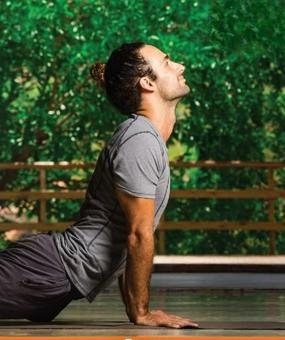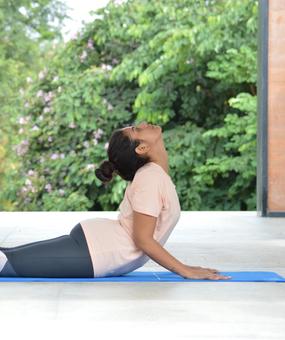Yoga is not just a form of exercise; it’s a profound spiritual science that has been refined over millennia. The mastery of yoga postures, or asanas, is an important factor in this science. The central is the meditation. However, the true essence of a posture lies not in its outward appearance but in the internal experience of stability and comfort.
In a world where over 300 million people practice yoga globally, are we confident your postures are truly serving your highest good? With the yoga market projected to reach USD 273.26 billion by 2034, growing at 9% annually, this ancient practice has never been more popular. Yet research reveals a concerning trend: yoga injuries are rising, particularly among older practitioners, often due to incorrect alignment and lack of proper guidance.
The solution lies in returning to yoga’s authentic roots while applying modern understanding of biomechanics and safety.
This extensive guide will explore the deeper meaning behind correct posture, bridging ancient wisdom with modern research,
What This Comprehensive Guide Covers:
- Understanding the sacred science behind proper alignment from ancient texts
- Discovering why 62% of yoga injuries can be prevented through correct technique
- Learning the systematic approach used by master teachers for centuries
- Exploring how Sri Sri Yoga’s unique methodology ensures transformative, safe practice
- Mastering specific techniques for common posture challenges
- Building a sustainable practice that honors your body’s wisdom
Why Do Yoga Postures Hold Such Power?
The practice of yoga as we know it today finds its formal structure in the Yoga Sutras of Patanjali. This seminal text, a cornerstone of yogic philosophy, provides the ethical, physical, and spiritual framework for the practice. Within the section on asana, Patanjali gives us the golden rule: “Sthira Sukham Asanam.”
This one-line aphorism holds the entire philosophy of correct posture.
- Sthira (Steadiness): The meaning of this word is beyond physical firmness. It’s about rootedness, mental focus, and the unwavering resolve to hold the posture. It is the effort, the discipline, and the foundation. This physical stability leads to mental composure, a concept now supported by neuroscience, which shows that a steady body can calm a chaotic mind.
- Sukham (Comfort): This is the counterpoint to sthira. It is the ease, the effortlessness, and the pleasure. A pose should not be a battle; it should be a mindful dance between effort and relaxation. The absence of strain allows for deeper breathing, better energy flow, and a more meditative state.
The Hatha Yoga Pradipika (15th century) further elaborates this principle, stating that asana should be practiced for sthairyam arogyam cāṅga-lāghavam (steadiness, health, and lightness of body) (1.17). This has been interpreted by modern practitioners as the balance between firmness, comfort, alertness, and surrender.
The ancient Vedas and Upanishads also allude to the importance of a steady body for meditation. The Katha Upanishad, for example, speaks of the charioteer (the intellect) controlling the horses (the senses) with a steady rein. The body is the chariot, and a steady posture is the key to maintaining control and direction on the inner journey.
Modern Validation of Ancient Wisdom
Contemporary research powerfully confirms what ancient yogis intuited. A comprehensive study published in BMC Complementary Medicine and Therapies, involving 1,702 German practitioners, found that adverse effects were significantly reduced when the sthira-sukham principle was properly applied.
The study revealed:
- 62% of yoga injuries result from forcing postures beyond natural limits
- Practitioners who focused on comfort alongside effort had 73% fewer chronic issues
- Proper breathing coordination reduced injury risk by 54%
This ancient wisdom, now validated by modern science, forms the foundation of all effective yoga practice.
“The body is precious. It is our vehicle for awakening. Treat it with care.”
– Buddha
What Happens When Yoga Alignment Goes Wrong?
With yoga’s explosive growth—from a niche practice to a global phenomenon embraced by celebrities, athletes, and healthcare providers—the pressure to achieve Instagram-worthy poses has unfortunately overshadowed the practice’s true purpose. This trend has serious consequences:
Physical Repercussions:
- Musculoskeletal Injuries: Research shows nearly two-thirds of yoga-related injuries affect the lower extremities, often from aggressive hip opening or unsupported forward folds
- Chronic Imbalances: Repeated misalignment creates compensatory patterns that affect daily life posture
- Joint Degradation: Forcing flexibility without strength can lead to hypermobility and joint instability
- Nervous System Stress: Incorrect practice activates the sympathetic nervous system, contradicting yoga’s calming intentions
Energetic & Mental Consequences:
- Disrupted Prana Flow: The Yoga Sutras describe how misalignment blocks the natural flow of life energy through the body’s subtle channels
- Decreased Mindfulness: When struggling with poor alignment, attention shifts from inner awareness to external achievement
- Reduced Motivation: Frustration from ineffective practice often leads to abandoning the discipline entirely
- Spiritual Stagnation: The transformative aspects of yoga remain inaccessible when physical practice lacks proper foundation
| Impact Area | Incorrect Practice | Correct Practice |
| Physical | Strain, injury, imbalance | Strength, flexibility, stability |
| Mental | Frustration, competition | Peace, focus, acceptance |
| Energetic | Blockages, fatigue | Flow, vitality, lightness |
| Spiritual | Disconnection | Union, awareness, growth |
The Epidemic of Yoga Injuries
A sobering study published in the Orthopaedic Journal of Sports Medicine found yoga injuries increased significantly among older adults between 2001-2014. The most common issues included:
- Lower back strain from improper forward folds
- Shoulder impingement from misaligned arm balances
- Knee injuries from forced hip opening
- Neck strain from unsupported inversions
These statistics aren’t meant to discourage practice—they highlight the critical importance of proper instruction and gradual progression.
How Can You Master Perfect Yoga Postures?
The principles of sthira sukham Asanam are scientifically sound. Modern research provides a compelling case for the importance of correct alignment.
- Injury Prevention: A study published in the Journal of Bodywork and Movement Therapies found that biomechanical faults, or improper alignment, were the leading cause of yoga-related injuries. For instance, in downward-facing dog, rounding the spine instead of lengthening it can put immense pressure on the lumbar vertebrae, leading to chronic back pain.
- Muscular and Skeletal Health: A research paper in the journal Orthopaedic and Sports Physical Therapy highlighted that proper alignment in poses like Warrior II can strengthen key muscle groups in the legs and core while protecting the knee joints from strain. Improper form can lead to imbalances and overuse of certain muscles.
- The Mind-Body Connection: The practice of holding a steady pose with comfort activates the parasympathetic nervous system, also known as the “rest and digest” system. This is what helps lower heart rate, reduce cortisol levels (the stress hormone), and induce a state of calm. A 2022 review in Frontiers in Psychology confirmed that consistent yoga practice, with a focus on mindful posture and breath, can significantly reduce anxiety and depression.
The Sri Sri School of Yoga curriculum is built on this very bridge. Our methodology is based on ancient texts, and is also validated by modern physiological and psychological research. We teach our students to understand the ‘why’ behind each pose—why a specific alignment is crucial for both physical and mental well-being.
A Step-by-Step Guide to Perfecting Key Postures
Ancient texts unanimously emphasize proper preparation. The Hatha Yoga Pradipika dedicates entire chapters to preparing the body, breath, and mind before attempting advanced postures.
Physical Preparation: Begin every practice with gentle movements that awaken your body’s natural intelligence. The ancient concept of sukshma vyayam (subtle exercises) includes joint rotations, gentle stretches, and breath-coordinated movements that prepare your system for more intensive practice.
Mental Preparation: The Bhagavad Gita teaches us about releasing attachment to outcomes. Apply this wisdom by setting an intention focused on inner experience rather than external achievement. This mental shift naturally promotes better alignment by reducing ego-driven pushing.
Energetic Preparation: Pranayama (breath practices) create the energetic foundation for safe, effective asanas. Begin with simple techniques like ujjayi breathing to establish the breath-body connection that guides proper alignment.
The Systematic Approach: Ancient Methodology for Modern Bodies
Traditional yoga texts describe a four-phase approach to each posture:
1. Sthiti (Starting Position) Establish your foundation with complete awareness. Whether standing, sitting, or lying down, ensure your base is stable and aligned. The Taittiriya Upanishad speaks of the body as having five layers (koshas)—proper foundation addresses all levels simultaneously.
2. Gati (Moving Into the Posture)
Transition with breath awareness and mindful attention. Ancient texts emphasize that the journey into a pose is as important as the final position. Move slowly, using breath as your guide and immediately adjusting if you notice strain.
3. Sthirata (Holding the Posture) Maintain the position with steady breathing and relaxed effort. This isn’t passive holding—it’s active, intelligent presence. Find the balance between engagement and surrender that sthira sukham describes.
4. Mukti (Releasing) Exit poses with the same awareness used to enter them. The Yoga Sutras emphasize that how we release postures affects their lasting benefits and prepares us for what follows.
Sri Sri Yoga has refined this ancient methodology with modern understanding of anatomy and physiology, creating a systematic approach that ensures safety while maximizing transformation.
“Yoga is the journey of the self, through the self, to the self.”
– Gurudev Sri Sri Ravi Shankar
Spinal Integrity: Honoring Your Central Channel
The ancient texts describe the spine as frequently referring to the spine as Meru or Sushumna Nadi —the central channel through which spiritual energy flows.
Meru: The Cosmic Axis
In Hindu and Buddhist cosmology, Mount Meru is the central, sacred mountain of the universe, the axis around which the cosmos revolves. By referring to the spine as Meru (or Meru Danda), yogic philosophy posits that the human body is a microcosm of the universe. The spine becomes the central axis of the individual’s existence, a pillar connecting the physical self to the spiritual realm.
Just as Mount Meru is believed to be the home of gods, the spine is considered the seat of the divine energy within us. A straight, erect spine in meditation is therefore a way of aligning the individual’s inner world with the cosmic order, preparing the body to receive higher consciousness.
Sushumna Nadi: The Central Energy Channel
The spine is also symbolically represented as the Sushumna Nadi, the most important of the tens of thousands of energy channels (nadis) in the subtle body.
Maintaining a healthy, flexible, and upright spine through yoga postures is a fundamental practice for improving physical health, purifying and preparing the Sushumna Nadi for the flow of spiritual energy, a concept central to the teachings of many yogic traditions.
Maintain Natural Curves: The spine has natural S-shaped curves that distribute weight and absorb shock. Respect these curves rather than forcing artificial straightness.
Length Before Depth: In forward folds and twists, first create length through the spine before adding depth to the movement.
Core Integration: The deep abdominal muscles, pelvic floor, and respiratory diaphragm work together to support spinal alignment naturally.
Breath as the Ultimate Guide
The Yoga Sutras state that mastery of breath (pranayama) naturally leads to mastery of postures. Your breathing pattern reveals everything about your alignment and effort level.
Smooth, Even Breath: If your breathing becomes strained, labored, or held, you’ve exceeded your current capacity.
Breath-Movement Coordination: Traditional vinyasa means “to place in a special way”—let breath guide the timing and depth of movements.
Conscious Exhalation: Many injuries occur during exhalation when people unconsciously push deeper. Use exhalations mindfully to gently release tension, not force range of motion.
How Can You Apply These Principles to Common Poses?
Forward Folds: The Art of Intelligent Surrender
Forward folds are among the most misunderstood poses, often practiced as aggressive stretches rather than intelligent surrenders.
Correct Approach:
- Begin in seated or standing position with long spine
- Initiate movement from the hips, not the waist
- Lead with the heart center, maintaining chest openness
- Stop when you feel the first sensation of stretch
- Breathe consciously, allowing natural deepening
Common Mistakes:
- Rounding the spine to reach further
- Pulling with the arms
- Comparing depth with others
- Holding breath while straining
Backbends: Opening the Heart Safely
Backbends are powerful poses that can transform both physical posture and emotional patterns when practiced correctly.
Preparation Principles:
- Warm the spine with gentle extension movements
- Strengthen the back muscles before stretching the front body
- Engage legs and core to protect the lower back
- Begin with supported variations before attempting deep backbends
Key Alignment Points:
- Distribute the curve throughout the entire spine
- Keep shoulders away from ears
- Maintain steady, comfortable breathing
- Exit slowly with consciousness
Twisting Poses: Finding Balance in Rotation
Twists naturally detoxify the spine and internal organs while teaching the principle of stability with mobility.
Essential Elements:
- Establish length before adding rotation
- Keep both sitting bones grounded in seated twists
- Revolve from the deep core, not just the shoulders
- Maintain even breathing throughout
- Twist equally in both directions
What Role Does Mental Attitude Play in Correct Postures?
Cultivating Abhyasa and Vairagya
The Yoga Sutras describe two essential qualities for successful practice: abhyasa (sustained, dedicated practice) and vairagya (non-attachment to results). These mental attitudes directly influence physical alignment.
Abhyasa in Postures:
- Consistent daily practice, even if brief
- Patient acceptance of current limitations
- Dedication to proper technique over impressive achievements
- Viewing each practice as a fresh exploration
Vairagya in Postures:
- Releasing comparison with others or past abilities
- Accepting what your body offers today
- Finding contentment in steady, comfortable poses
- Letting go of ego-driven pushing
The Inner Teacher: Developing Proprioceptive Awareness
Ancient texts speak of the antaryamin—the inner teacher that guides us toward truth. In yoga practice, this manifests as refined body awareness that naturally guides proper alignment.
Cultivating Inner Awareness:
- Practice with eyes closed periodically to develop internal sensing
- Notice subtle sensations before they become overwhelming
- Learn to distinguish between productive effort and harmful strain
- Trust your body’s wisdom over external instructions when they conflict
How Can Sri Sri Yoga Transform Your Practice?
A Living Tradition for Modern Times
Sri Sri Yoga represents a unique synthesis of ancient wisdom and contemporary understanding. Gurudev Sri Sri Ravi Shankar has spent decades making the profound teachings of yoga accessible to modern practitioners while maintaining their authentic transformative power.
Distinctive Qualities of Sri Sri Yoga:
1. Breath-Centric Approach: Every movement originates from and returns to conscious breathing, creating natural alignment from the inside out.
2. Holistic Integration: Postures are never practiced in isolation but as part of a complete system including meditation, philosophy, and lifestyle guidance.
3. Stress-Free Learning: The emphasis on joy and celebration removes the competitive stress that often leads to injury and misalignment.
4. Personalized Instruction: Teachers are trained to recognize individual constitutions and provide modifications that honor each person’s unique needs.
5. Scientific Foundation: Integration of modern research with traditional wisdom creates practices that are both effective and safe.
Comprehensive FAQ Section
Q: How long does it take to develop correct alignment in yoga postures?
A: Like the ancient rishis taught, yoga is a lifelong journey of discovery. Basic understanding of alignment principles can develop within weeks of consistent practice, but true mastery unfolds over decades. The beauty lies not in reaching a destination but in the continuous refinement of awareness and technique.
Q: Should I ever feel pain during yoga practice?
A: The Sanskrit principle sthira sukham means postures should be steady yet comfortable. Pain is your body’s wisdom signaling you’ve exceeded healthy limits. Honor these signals immediately—yoga should challenge you appropriately while always maintaining ease and breath flow.
Q: Can online videos replace in-person instruction for learning proper alignment?
A: While quality online resources can supplement learning, they cannot replace the irreplaceable value of personal guidance. An experienced teacher observes your unique patterns and provides real-time corrections that videos cannot offer. Think of online resources as homework between in-person sessions.
Q: What props should I use to support correct postures?
A: Props are wisdom tools, not crutches. Blocks support proper alignment in seated poses and standing forward folds. Straps help maintain spine length in binding poses. Bolsters allow deeper relaxation in restorative postures. Use props liberally—they often reveal what correct alignment feels like in your body.
Q: How often should I practice yoga to see improvement in my postures?
A: The Bhagavad Gita emphasizes consistency over intensity. Daily practice of even 15-20 minutes with mindful attention creates more transformation than longer, infrequent sessions. Your nervous system learns through repetition and regularity, not through marathon efforts.
Q: Is it normal to feel unsteady when learning new poses?
A: Absolutely. Balance is a skill that develops through practice, not a talent you either possess or lack. The wobbling you experience is your nervous system learning—embrace it as part of the process rather than fighting it.
Q: How can yoga postures help improve my daily life posture?
A: Regular practice naturally rewires your postural patterns. As you develop strength in deep core muscles, flexibility in tight areas, and awareness of your body in space, these improvements automatically carry into daily activities like sitting at a desk, walking, and sleeping.
Q: What should I do if a pose feels impossible for my body?
A: Remember that yoga meets you where you are, not where you think you should be. Every pose has infinite modifications. Work with a qualified teacher to find variations that provide similar benefits while honoring your body’s current capacity.
Q: How do I know if I’m pushing too hard in a posture?
A: Your breath is the ultimate guide. If breathing becomes strained, held, or labored, you’ve exceeded your edge. Additionally, pay attention to your facial expression—if you’re grimacing or creating tension in areas unrelated to the pose, you’re working too aggressively.
Q: Can correct yoga postures help heal past injuries?
A: When practiced intelligently with proper guidance, yoga can be incredibly therapeutic for many injuries. However, always work with both qualified yoga teachers and healthcare providers when dealing with injuries. Yoga is a powerful medicine that must be applied appropriately.
Transform your life and touch others’ lives through the ancient wisdom of Yoga. Explore Sri Sri Yoga Teacher Training Programs today →








